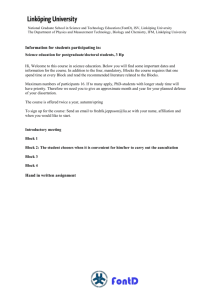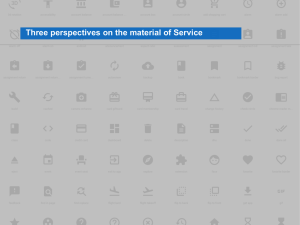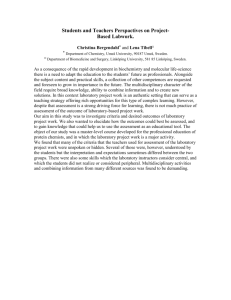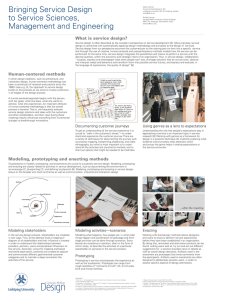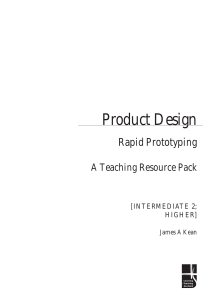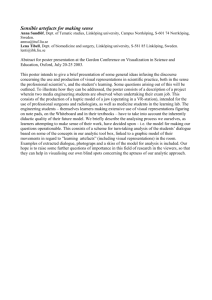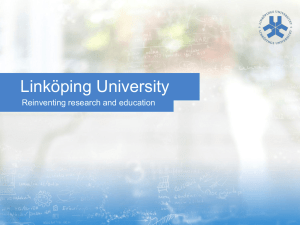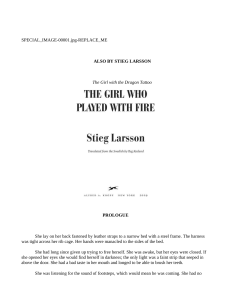Learning, Changing, Growing
advertisement
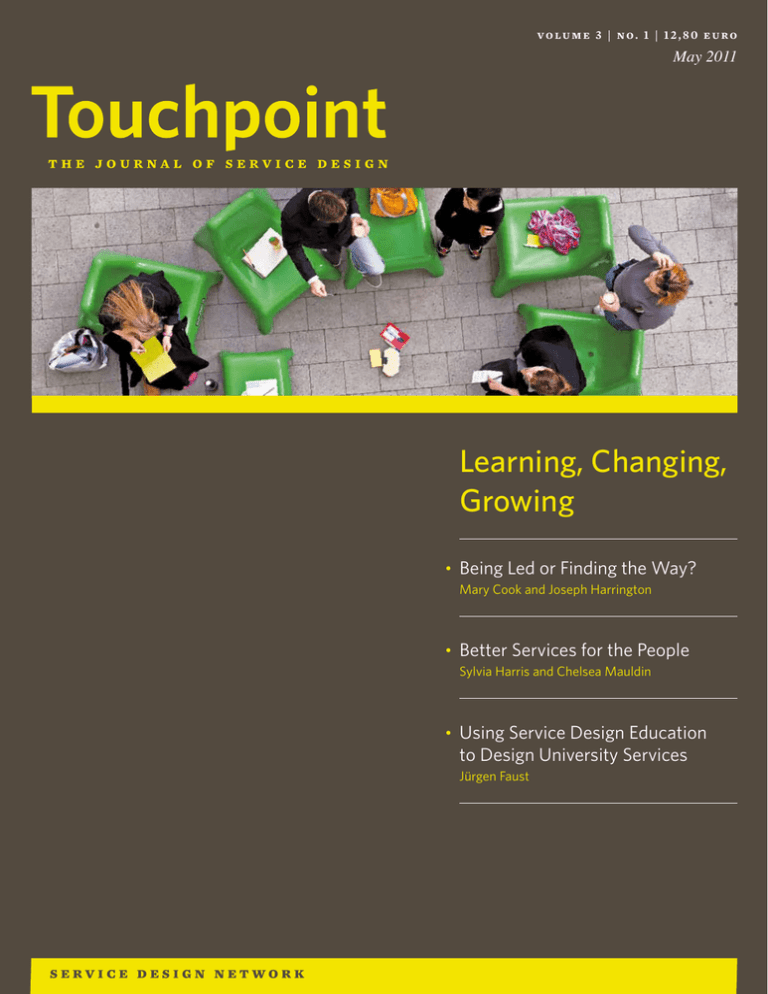
volume 3 | no. 1 | 12,80 euro May 2011 Learning, Changing, Growing • Being Led or Finding the Way? Mary Cook and Joseph Harrington • Better Services for the People Sylvia Harris and Chelsea Mauldin • Using Service Design Education to Design University Services Jürgen Faust #*&%*$&/#& man i'm late. i wonder which building i'm going to? oh no, more people in the way! 52 where to park? By Johan Blomkvist, Stefan Holmlid, Fabian Segelström Prototyping a Service Design Curriculum Integrating Current Research in Teaching This article describes how we developed a new service design curriculum and integrated current research into the courses. We did this by prototyping the service design curriculum together with our design masters students. The new curriculum is aimed at students who already have basic design skills and focuses on helping the students to reflect on the new challenges that service design brings compared to other design disciplines. Current research into the tools and techniques of service design has been integrated into the curriculum as a catalyst for the content of the courses given according to the curriculum. Why We Needed a New Curriculum Our curriculum from 2005 was a projectbased curriculum, run as two courses: one in a design studio format and one with an information and communication technologies (ICT) perspective. The ICT course was withdrawn after a few years. The curriculum and the courses were tightly interwoven with current research projects. In 2009, we decided to change the curriculum, with the aim of finishing the implementation of the curriculum in spring semester 2012. The rationale was twofold: 1. To restructure and modernise the service design studio course from 2005 2.To prepare the curriculum for growth over time, from courses with fewer than 10 students to those with more than 30 students The outcome was a curriculum aimed at introducing service design to students who already have basic design skills, using a curriculum that can be easily adapted to fit class size and the design background of the students. How We Did It We began development by investigating various perspectives on service design in relation to the amount of design knowledge the students have when they take the service design course. All service design courses currently given at Linköping University are held at a masters level. Knowing which programmes students were coming from, we were able to assume that the students had basic design skills when starting the course. Therefore, the focus of teaching Johan Blomkvist has a cognitive science background with a design twist, and is currently working on his Ph.D thesis at Linköping University. Stefan Holmlid is associate professor at Linköping University. He co-founded the Service Design Network and the Service Design and Service Innovation Conference. Fabian Segelström is a PhD student focusing on stakeholder involvement in service design and how insights thereof are visualized. 53 By Johan Blomkvist, Stefan Holmlid, Fabian Segelström would be the specific tools and techniques used within service design. Before starting the design segment, the students were introduced to the concept of service and the specific challenges of designing for services. Furthermore, we made the strategic decision to base the course on current developments in design research2. Research has identified visualisations of services4 and service prototyping1 as areas in which the nature of services lead to new challenges compared to the traditional design fields. 01. 02. visualisations. To put visualisations into context with the help of current research, students were introduced to the model by Diana, Pacenti & Tassi3 to help them organise their thinking. Furthermore, they were introduced to the most common visualisation techniques. The students were then encouraged to explore the different techniques and choose the ones most suitable for their needs. As students were assumed to already possess basic design skills such as ideation, we encouraged them to spend as little time as possible on finding The Idea, but rather to pick one that they instinctively believed in. The First Curriculum Draft Students then immediately started with prototyping activities. The last The first draft of the curriculum was stage of the design process focused heavily on the theoretical importance prototyped during the spring of 2010 and was evaluated together with the students. of prototyping holistic representations of services. The students were inThe students were given redesign projects troduced to a list of perspectives from which prototyping and prototypes have been discussed in previous design literature. These perspectives related to different areas of the campus, with lesson plans that focused on specific were then used to facilitate their understanding of service prototyping challenges and to support communication around the features of their activities particular to service design. prototypes. The prototypes were created using physical, virtual, graphiThe different parts of the service design process were introduced to the students in cal and interactive components, thus developing the skills of the students in a diversity of domains. The new curriculum was well received by the a segmented way. students in general, but some changes were suggested. The activities – or phases of the service design process – that the students were expected to learn about were stakeScaling up: The Second Curriculum Draft holder research, visualising research data, The second iteration of the curriculum was adapted, based on student representing ideas on a theoretical level feedback and our own evaluations. Another challenge for the second and prototyping ideas. The students all had round was that we developed it for a group of 33 design engineers in a experience in an ethnographic approach more traditional classroom environment. to design research, so the importance of Based on the feedback from the previous year, we changed the design identifying stakeholders and service flows challenge to feel less segmented and to focus on a holistic designing experiwere highlighted in this segment. ence. This changed the curriculum in a number of ways: in the initial stage, Halfway through the research students were given more freedom in choosing the scope of their project phase, the students were introduced to and asked to identify the problem area they wanted to work with. 54 service design education A product prototype aimed at improving a touchpoint of the service experience at a restaurant on campus | 02. Photos visualising research data collected during a design probe study 01. To let the students focus on visu­alisation techniques throughout their projects rather than in one segment, we specified which types of techniques students were to use in the different stages of the course. Various types of system and actor maps were used after the stakeholder research, whereas customer journeys and blueprints were used in the ideation phase. Finally, in the prototyping phase, students were instructed to storyboard their ideas before creating video prototypes. Based on feedback from the first iteration, the ideation phase was extended in this course to highlight a more holistic design process. The students spent more time developing their service ideas by trans­ forming insights from research into configurations of networks of value creation. Insights from the Second Draft As of this writing, we are in the final weeks of the course for Spring 2011, but some changes for the next iteration of the curriculum have already been identified. Primarily, we observed that, when given the opportunity to choose what to design in a given context, the students mostly preferred to develop new services rather than to design improvements to existing services. This had two consequences: 1. Students struggled with identifying all stakeholders of the new service models and had difficulty finding ways of visualising their insights from the stakeholder research 2.The students might get the wrong idea of service design practice. Most commercial projects are aimed primarily at improving existing services rather than generating new service ideas For these two reasons, courses in the next iteration of the curriculum will focus on course activities where students consider existing services as their starting point. We will emphasise that idea generation should be made with respect to improvements, rather than radical innovation. We recommend that skills on improving existing services are seen as a higher priority than skills for coming up with new ones for students, in order to align learning with their future role. How We Use the Curriculum During spring 2011, the curriculum has supported us in the development and performance of a solid, pluralistic and multi-disciplinary studio course in service design for masters students in Design, and a more traditionally structured course for Design Engineering students. It has also been used to develop a micro-module in service design as part of a course on Industrial Service Development for students in industrial engineering. We are starting to develop the contents of a PhD course in service design, and will also use it for the module developed and given with the Business & Design lab in Gothenburg later in 2011. • References 1 Blomkvist, J. (2011). Conceptualising Prototypes in Service Design. Linköping, Sweden: Linköping University. 2 Blomkvist, J., Holmlid, S., & Segelström, F. (2010). This is Service Design Research. In M. Stickdorn, & J. Schneider (Eds.), This is Service Design Thinking (pp. 308-315). Amsterdam, Netherlands: BIS Publishers. Diana, C., Pacenti, E., & Tassi, R. (2009). Visualtiles Communication tools for (service) design. First Nordic Conference on Service Design and Service Innovation. Oslo, Norway. 4 Segelström, F. (2010). Visualisations in Service Design. Linköping, Sweden: Linköping University. 3 55 SAN FRANCISCO This year’s Service Design Conference will take place at San Francisco, California, USA. The topic From Sketchbook to Spreadsheet is about exploring the critical relationship between service design and business. The call for contribution is open now! Watch the SDN website to stay updated! About Service Design Network The Service Design Network is a forum for practitioners and academics to advance the nascent field of service design. Our purpose is to develop and strengthen the knowledge and expertise in the science and practise of innovation. Service Design Network Office | Ubierring 40 | 50678 Cologne | Germany | www.service-design-network.org Photo: Calibas, commons.wikimedia.org/wiki/File:Golden_Gate_bridge_pillar.jpg service design conference
